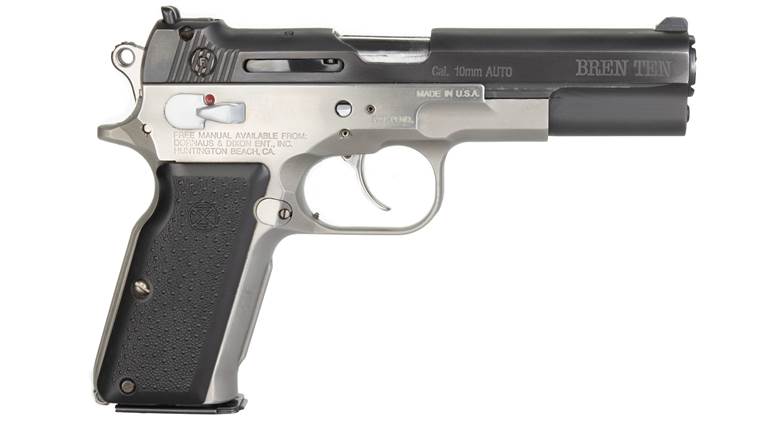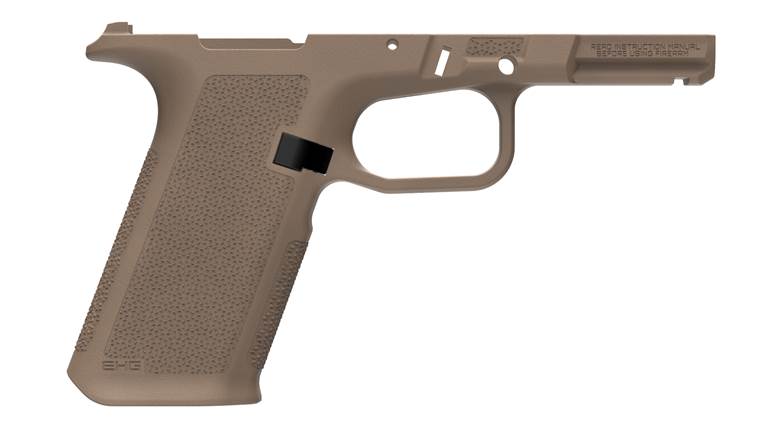
I recently visited the Federal Premium Ammunition facility in Anoka, Minn., which included a day and a half in the company’s Research and Testing department. My goal was to shoot two newer brands of Federal self-defense ammunition into ballistic gelatin, generally following the law enforcement guidelines for self-defense handgun ammunition as set out by the Federal Bureau of Investigation (FBI). 
The two brands of ammunition tested were the Personal Defense HST 10 mm Auto, firing a 200-gr. HST hollow-point bullet; and, Federal Hydra-Shok Deep in 9 mm (135-gr. Hydra-Shok Deep bullet) and 45 Auto (210-gr. Hydra-Shok Deep bullet). 

Test Procedures
The FBI Protocol has many elements to its ammunition protocol, but for practicality, I limited my testing to three of the most common: firing into bare gelatin; firing into gelatin covered with layers of cloth to mimic heavy clothing; and, firing through two pieces of half-inch drywall and then into gel.
Each gel block measured 16.5” x 8” x 11,” and I fired three rounds of each brand and caliber into the blocks. I then measured how far each projectile had penetrated the gel and cut out the projectiles to measure how much they expanded and how much weight they retained.

The testing took place in an underground tunnel, with the gel blocks placed 10 feet from my handguns' muzzles.
For the heavy clothing test, the front of a gel block was covered in a T-shirt layer, a medium-weight, felt-like layer, and a quilted, jacket-like layer.
For the drywall testing, Vitale placed two .5" sheets of drywall approximately 4" apart, and I shot into and through the two sheets, with the gel blocks sitting 14" from the last drywall sheet.
For weight measurements after the bullets were retrieved, I used an RCBS Rangemaster 2000 electronic scale.
Later, at my home range, I fired the ammunition for accuracy.
Going Deep
Federal introduced the Hydra-Shok Deep line in 2018. The ammo’s main selling point was that the bullets featured a more robust center post mated with a core design, and together these two features helped the bullets penetrate to critical depths through common self-defense barriers without over-penetrating. The hardened center post drives on through barriers, while the hollow point’s petals peel back.
Federal’s press materials on the Hydra-Shok Deep claimed the bullets would consistently penetrate to the 15” in bare gelatin, considered the “optimum depth” by the FBI testing protocol.
Originally launched in 9 mm, the 2019 Hydra-Shok additions were in 40 S&W and 45 Auto. I choose to test the original 9 mm load and the new .45 Auto option.
Hydra-Shok Deep bullets feature hardened center posts that maintain their shape during penetration, like these Hydra-Shok .45 Autos.
Hydra-Shok Deep 9 mm bullets after gel testing.
Hydra-Shok Deep 9 mm
To test the Hydra-Shok Deep in 9 mm, I used a Glock 17 and a Ruger Security 9.
Bare Gel: Average penetration, 15.0.” Average expansion, .53.” Average weight after firing, 135 grains.
Cloth-Covered Gel: Average penetration, 16.0.” Average expansion, .52.” Average weight after, 135 grains.
Drywall + Gel: Average penetration, 16.8.” Average expansion, .52.” Average weight after, 133 grains.
Hydra-Shok Deep 45 Auto
To test the Hydra-Shok Deep in 45 Auto, I used a Glock 21 Gen4 pistol.
Bare Gel: Average penetration, 16.25.” Average expansion, .63.” Average weight after firing, 201 grains.
Cloth-Covered Gel: Average penetration, 16.0.” Average expansion, .58.” Average weight after, 210 grains.
Drywall + Gel: Average penetration, 16.5.” Average expansion, .62.” Average weight after, 208 grains.
The Big 10
The 10 mm Auto continues to experience a resurgence. Not only are hunters using the 10 mm, but consumers are buying into the round for home-defense. There are even a few concealed carry handguns made in this powerful caliber, including the accurate and ergonomic Glock 29 Gen4.
For the Personal Defense HST 10 mm Auto, Federal took the existing HST bullet design and built it into a 200-gr., 10 mm Auto projectile. HST bullets are made to provide nearly 100-percent weight retention, with bullet jacket and core holding together throughout. To keep expansion dynamic, Federal designed the HST hollowpoint bullet so it wouldn’t plug up as it passes through various barriers.
Of note, Federal Premium HST already was offered in two 9 mm loads (one with a 124-gr. bullet, another with a 147-gr. projectile), a 40 S&W and a 45 Auto.
A selection of Personal Defense HST 10 mm Auto bullets retrieved from ballistic gel.
Personal Defense HST 10 mm Auto
Firearm used: Springfield Armory Operator 1911 with a 5” barrel.
Bare Gel
Average penetration: 14.75.”
Average expansion: .78”
Average weight after firing: 201 grains
Cloth-Covered Gel
Average penetration: 17.5”
Average expansion: .68”
Average weight after firing: 201 grains
Drywall + Gel:
Average penetration: 16.5”
Average expansion: .72”
Average weight after firing: 199 grains
Impressive wound channels created by HST 10 mm Auto rounds fired into ballistic gel.
Accuracy
Back at my home range, I performed quick accuracy testing of the rounds, firing off-hand at targets seven yards away. I’ve settled on the seven-yard test as a good one for self-defense rounds and handguns, reasoning that: most self-defense scenarios are going to be relatively close, and the shooting will be off-hand, not from a rest. Plus, if an ammunition-handgun pairing has good accuracy at seven yards, the accuracy should be even better at three yards, often cited as the average distance law enforcement personnel use their duty arms in such situations. And, if good at seven yards, accuracy should be more than adequate 10 to 12 yards. 
For all three brands of ammunition, accuracy was good to very good. For the HST10 mm Auto, I used a Springfield Armory XD-M OSP. I had no problem pegging five-round groups at 1.25” to 1.5.” My best group was right at 1.22.” Average muzzle velocity was 1,115 f.p.s.
Testing the Hydra-Shok 9 mm was done with a Stoeger STR-9 with a 4.17” barrel. Any time I took my time, I was able to place five shot at an inch of better. My best group was an impressive .87.” Muzzle velocity averaged 1,043 f.p.s.
For the Hydra-Shok 45 Auto, I used a Devil Dog Arms 3.5 Standard 1911 sporting a 3.5” barrel. Groups here averaged 1.3” with my best group a nice, tight .97” cluster. Average muzzle velocity was 963 f.p.s.
Muzzle velocities were measured with a PACT Professional XP Chronograph from Brownell’s, with the unit approximately six feet from the muzzle, firing 10 rounds per ammunition brand.
Summary
Once retrieved from the gel, the Hydra-Shok bullets exhibited minimal expansion at about .52” for the 9 mm, and .60” for the .45 Auto. However, as they were traveling through the gel, the Hydra-Shok projectiles were opening to a much larger expansion for several inches. So, the final measured expansion is not truly the expansion the round experiences.
I point this out as the Hydra-Shok expansion will seem to some as fairly anemic for self-defense rounds. They did for me, too--initially. But, when I examined the gel, I saw that the bullets began expanding a couple of inches into the gel blocks and opened up nicely for six to seven inches; then, the wound channels began narrowing as the projectiles went forward and the petals of the hollow points peeled back against the shank of the bullets.
Of course, look over the weights measured, and it’s clear these Hydra-Shok bullets deliver a full punch at nearly full weight. And, in both calibers, the Hydra-Shoks penetrated at or just over the FBI’s “sweet spot” of 15.”
I’d use this ammunition in my carry guns without hesitation.
Speaking of wound channels, what I examined with the HST 10 mm has me thinking it is time for me to purchase a 10 mm pistol for daily carry—and load it with Federal’s HST 10 mm.
The terminal expansion measured with the bullets, no matter the barrier, was approximately double the initial size of the bullets. And the mushroom on every round was fronted with very sharp-edged petals that would make an actual wound channel even more significant.
At approximately 1.5” into the gel, the petals on the HST hollow point opened up and stayed open for about another seven inches, tearing a very wide channel. The second half of the bullets’ paths were done at essentially the terminal expansion of twice the 10 mm diameter.
Most 10 mm handguns I’ve used were full-sized 1911s for hunting, often with six-inch barrels—definitely not carry friendly rigs. So, I guess I subconsciously wrote off the 10 mm as a carry gun. No more.
I need to look into the Glock 29 Gen4 with its 3.8” barrel, and similar sized 10 mms, to ascertain how they feel on-body. In my extensive experience in gel testing—and witnessing even more of it—I have never seen the kind of wound channels I saw with the HST 10 mm.





































